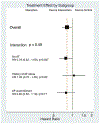Atrial Fibrillation in Heart Failure With Preserved Ejection Fraction: The TOPCAT Trial
- PMID: 30007557
- PMCID: PMC12582515
- DOI: 10.1016/j.jchf.2018.05.005
Atrial Fibrillation in Heart Failure With Preserved Ejection Fraction: The TOPCAT Trial
Abstract
Objectives: This study assessed the relationship between atrial fibrillation (AF) and outcomes in the TOPCAT (Treatment of Preserved Cardiac Function Heart Failure With an Aldosterone Antagonist) trial, to evaluate whether AF modified the treatment response to spironolactone and whether spironolactone influenced post-randomization AF.
Background: AF is common in heart failure with preserved ejection fraction (HFpEF) and likely contributes to increased risk of adverse outcomes.
Methods: A total 1,765 patients enrolled in TOPCAT trial in North and South America were divided into 3 groups: no known AF, history of AF without AF at enrollment, and AF found on the electrocardiogram (ECG) at enrollment. We assessed outcomes and treatment response to spironolactone in all groups, and the association between post-randomization AF and outcomes in patients free of AF at baseline. The primary outcome of the TOPCAT trial was a composite of cardiovascular mortality, aborted cardiac arrest, or heart failure hospitalization.
Results: A total of 760 patients (43%) had a history of AF (18%) or AF on ECG at enrollment (25%). The highest adjusted risk was associated with AF at enrollment (primary outcome, hazard ratio: 1.34; 95% confidence interval: 1.09 to 1.65; p = 0.006; and an increased early risk of secondary outcomes). Neither history of AF nor AF at enrollment modified the beneficial treatment effect of spironolactone. Post-randomization AF, which occurred in 6.3% of patients, was not influenced by spironolactone treatment, but was associated with an increased early risk of the primary outcome (hazard ratio: 2.32; 95% confidence interval: 1.59 to 3.40; p < 0.0001) and secondary outcomes.
Conclusions: AF at enrollment was associated with increased cardiovascular risk in HFpEF patients in the TOPCAT study. Post-randomization AF, which was associated with an increased risk of morbidity and mortality, was not influenced by spironolactone. (Treatment of Preserved Cardiac Function Heart Failure With an Aldosterone Antagonist [TOPCAT]; NCT00094302).
Keywords: atrial fibrillation; echocardiography; heart failure outcomes; heart failure with preserved ejection fraction; spironolactone.
Copyright © 2018 American College of Cardiology Foundation. Published by Elsevier Inc. All rights reserved.
Figures


Comment in
-
Mineralocorticoid Receptor Antagonism for the Treatment of AF and HFpEF: Preserving Hope.JACC Heart Fail. 2018 Aug;6(8):698-700. doi: 10.1016/j.jchf.2018.06.010. Epub 2018 Jul 7. JACC Heart Fail. 2018. PMID: 30078393 No abstract available.
References
-
- Owan TE, Hodge DO, Herges RM, Jacobsen SJ, Roger VL, Redfield MM. Trends in prevalence and outcome of heart failure with preserved ejection fraction. N Engl J Med 2006;355:251–9. - PubMed
-
- Kotecha D, Lam CS, Van Veldhuisen DJ, Van Gelder IC, Voors AA, Rienstra M. Heart failure with preserved ejection fraction and atrial fibrillation: vicious twins. J Am Coll Cardiol 2016;68:2217–28. - PubMed
-
- Olsson LG, Swedberg K, Ducharme A, et al. , CHARM Investigators. Atrial fibrillation and risk of clinical events in chronic heart failure with and without left ventricular systolic dysfunction: results from the Candesartan in Heart failure-Assessment of Reduction in Mortality and morbidity (CHARM) program. J Am Coll Cardiol 2006;47:1997–2004. - PubMed
Publication types
MeSH terms
Substances
Associated data
Grants and funding
LinkOut - more resources
Full Text Sources
Other Literature Sources
Medical

